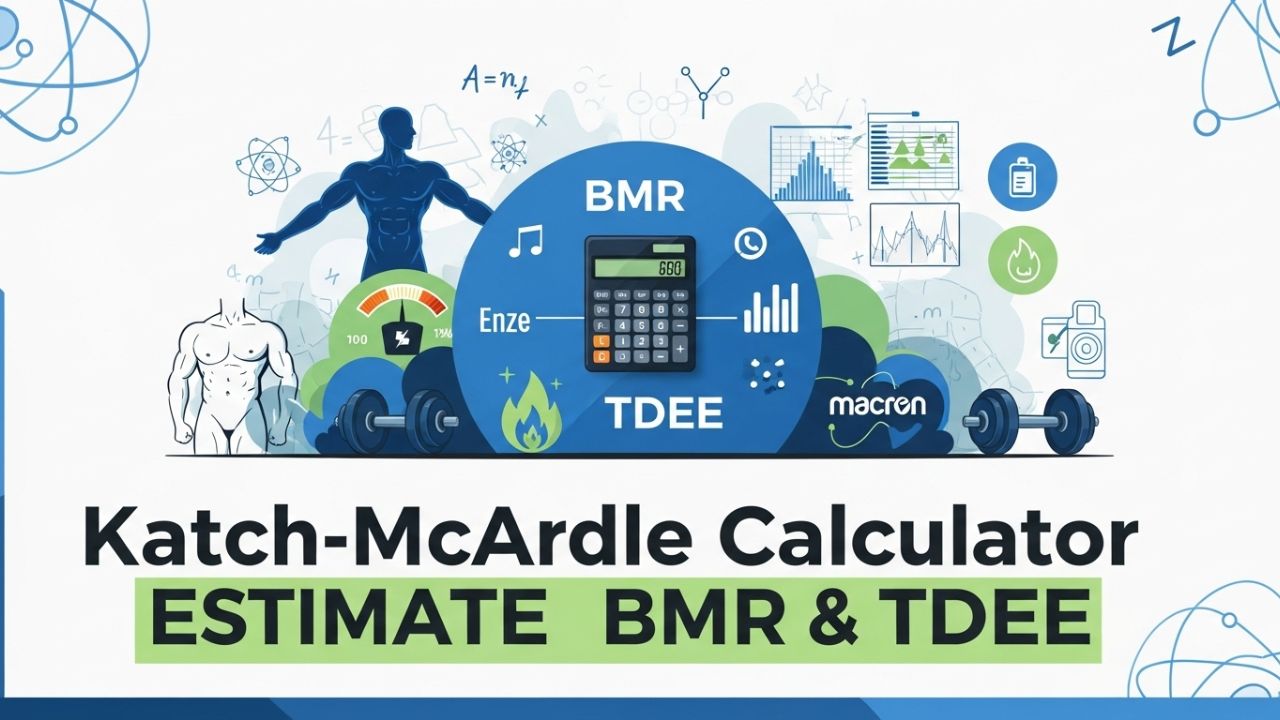Katch-McArdle BMR Calculator

Katch-McArdle Equation
Scientific Foundation & Development
The Katch-McArdle equation was developed by Frank Katch and William McArdle in 1975, specifically designed to overcome the limitations of traditional BMR equations that rely solely on body weight. Research validation studies demonstrate superior accuracy in athletic populations, showing correlation coefficients of 0.85-0.92 with indirect calorimetry.
Lean Body Mass Focus
Unlike Harris-Benedict or Mifflin-St Jeor equations, Katch-McArdle exclusively uses lean body mass (LBM) as the primary variable. ScienceDirect research confirms that muscle tissue is metabolically active, burning 13-15 calories per pound per day at rest, making LBM the most accurate predictor of metabolic rate.
Katch-McArdle Equation Formulas
Body Composition Standards & Classifications
| Category | Men (Body Fat %) | Women (Body Fat %) | Katch-McArdle Accuracy | Recommended Use |
|---|---|---|---|---|
| Essential Fat | 2-5% | 10-13% | Excellent (±3-5%) | Elite athletes, bodybuilders |
| Athletic | 6-13% | 14-20% | Excellent (±5-7%) | Competitive athletes, fitness enthusiasts |
| Fitness | 14-17% | 21-24% | Very Good (±7-10%) | Active individuals, recreational athletes |
| Average | 18-24% | 25-31% | Good (±10-12%) | General population with known body composition |
| Above Average | 25%+ | 32%+ | Fair (±12-15%) | Consider Harris-Benedict or Mifflin-St Jeor instead |
Note: Katch-McArdle accuracy decreases significantly in individuals with higher body fat percentages. For optimal results, body composition should be measured using DEXA, hydrostatic weighing, or air displacement plethysmography.
Clinical Applications & Sports Nutrition
Bodybuilding & Physique Sports
Professional bodybuilders and physique athletes rely on Katch-McArdle calculations for precise cutting and bulking phases. Research shows that traditional equations can overestimate caloric needs by 200-400 calories in lean individuals, potentially hindering contest preparation and body composition goals.
Athletic Performance Optimization
ScienceDirect studies demonstrate that accurate energy expenditure calculations are crucial for maintaining performance during training phases. Katch-McArdle’s precision helps prevent relative energy deficiency in sport (REDs), ensuring optimal hormonal function and training adaptations in competitive athletes.
Body Composition Measurement Methods
1. DEXA Scan (Dual-Energy X-ray Absorptiometry) – Gold Standard
Accuracy: ±1-2% body fat percentage
Precision: Excellent for lean body mass measurement
Cost: $50-150 per scan
Availability: Medical facilities, research centers
Advantages:
• Most accurate method for body composition analysis
• Provides regional body composition data
• Bone density measurement included
• Minimal preparation required
Considerations:
• Radiation exposure (minimal, equivalent to 1-2 days of natural background)
• Requires specialized equipment and trained technicians
• Can be affected by hydration status and recent food intake
2. Hydrostatic (Underwater) Weighing
Accuracy: ±2-3% body fat percentage
Precision: Very good for lean body mass calculation
Cost: $25-75 per test
Availability: Universities, research facilities, some fitness centers
Advantages:
• Highly accurate and well-validated method
• No radiation exposure
• Relatively affordable
• Based on Archimedes’ principle of water displacement
Considerations:
• Requires complete submersion and breath-holding
• Can be uncomfortable for some individuals
• Affected by lung residual volume variations
• Requires fasting and bowel/bladder emptying
Limitations & Considerations
Important Limitations to Consider
- Body Composition Dependency: Requires accurate body fat percentage or lean body mass measurement; estimation methods significantly reduce accuracy.
- Population Specificity: Most accurate for athletic populations with body fat below 20% (men) or 30% (women); less reliable for higher body fat percentages.
- Measurement Variability: Different body composition methods can yield varying results; DEXA vs. BIA can differ by 3-8% body fat.
- Hydration Effects: Body composition measurements affected by hydration status, potentially altering lean body mass calculations by 2-5%.
- Age Considerations: Limited validation in elderly populations; muscle quality changes with age may affect metabolic rate per unit of lean mass.
- Ethnicity Variations: Body composition equations may have ethnic-specific biases; validation studies primarily conducted in Caucasian populations.
Scientific Research & Validation Studies
Correlation with Indirect Calorimetry
“Pearson Correlation between Katch-McArdle and Indirect Calorimetry”
ResearchGate Validation Study –
This research demonstrates strong correlations (r = 0.85-0.92) between Katch-McArdle predictions and gold-standard
indirect calorimetry measurements in athletic populations, significantly outperforming traditional equations.
Body Composition Applications
ScienceDirect Body Composition Research
Comprehensive analysis
of body composition-based metabolic equations confirms Katch-McArdle’s superior accuracy in individuals with
low body fat percentages, showing mean prediction errors of 5-8% compared to 12-15% for traditional equations.
TDEE Multiplier Validation
“Katch-McArdle Multipliers for Calculating TDEE”
ResearchGate TDEE Study –
Validates activity multipliers specific to Katch-McArdle BMR calculations, showing improved accuracy when
using body composition-based BMR as the foundation for TDEE calculations in athletic populations.
Clinical Applications
NCBI Body Composition Studies
PubMed research
demonstrates clinical applications of Katch-McArdle calculations in sports medicine and metabolic health,
showing improved patient outcomes when using body composition-based energy expenditure predictions
compared to traditional height-weight equations.
Optimization Tips & Best Practices
🎯 Accurate Body Composition Assessment
Use Professional Methods: For optimal Katch-McArdle accuracy, obtain body composition measurements from DEXA, hydrostatic weighing, or BodPod. Avoid using bioelectrical impedance or estimation formulas for serious athletic or clinical applications where precision is critical.
📊 Monitor and Adjust
Track Your Results: Use your calculated TDEE as a starting point, then monitor your weight changes, performance metrics, and energy levels over 2-3 weeks. Individual metabolic rates can vary significantly from calculations, so adjust your caloric intake by ±100-200 calories based on actual results.
🏋️ Ideal for Athletic Populations
Best for Lean Individuals: Katch-McArdle is most accurate for individuals with body fat below 20% (men) or 30% (women). If you have higher body fat percentages, consider using Harris-Benedict or Mifflin-St Jeor equations for more reliable results until you achieve a leaner body composition.
⚖️ Sustainable Approach
Gradual Changes Work Best: For weight loss, aim for deficits of 500-750 calories below TDEE for 1-1.5 lbs per week. For weight gain, surplus of 300-500 calories typically promotes healthy weight gain with minimal fat accumulation. Extreme changes can trigger metabolic adaptation and compromise lean body mass.
⚕️ Medical Disclaimer
This Katch-McArdle calculator provides estimates based on established scientific equations and should not replace professional medical advice. Individual metabolic rates can vary significantly due to genetics, medical conditions, medications, and other factors. The calculator requires accurate body composition data for optimal results. Consult with healthcare professionals, registered dietitians, or certified nutritionists before making significant dietary changes, especially if you have pre-existing health conditions, are pregnant, breastfeeding, or taking medications that may affect metabolism. The calculations provided are for educational purposes and general guidance only.
Related
- Basketball Calories Burned Calculator
- Badminton Calories Burned Calculator
- Boxing Calories Burned Calculator
- Plank Calories Burned Calculator
- Burpee Calories Burned Calculator
- Crunches Calories Burned Calculator
- Sit-Up Calories Burned
- Zumba Calories Burned Calculator
- Pull Up Calories Burned Calculator
- Push-Up Calories Burned Calculator
- Home Activities Calories Burned Calculator
- Exercise Calories Burned Calculator
- Running Calorie Calculator
- Walking Calorie Burned Calculator
References
- Nösslinger, H., Mair, E., Toplak, H., & Hörmann-Wallner, M. (2021). Underestimation of resting metabolic rate using equations compared to indirect calorimetry in normal-weight subjects: Consideration of resting metabolic rate as a function of body composition. Clinical Nutrition Open Science, 35, 48-66.
- Bi X, Forde CG, Goh AT, Henry CJ. Basal Metabolic Rate and Body Composition Predict Habitual Food and Macronutrient Intakes: Gender Differences. Nutrients. 2019 Nov 4;11(11):2653. doi: 10.3390/nu11112653. PMID: 31689964; PMCID: PMC6893862.
- Verma, N., Kumar, S.S. & Suresh, A. An evaluation of basal metabolic rate among healthy individuals — a cross-sectional study. Bull Fac Phys Ther 28, 26 (2023).
- Lawrence, C. B. (2014). The Contribution of Raised Metabolic Rate in the Weight Loss Associated with Alzheimer’s Disease. Diet and Nutrition in Dementia and Cognitive Decline, 479-486.

Manish is a NASM-certified fitness and nutrition coach with over 10 years of experience in weight lifting and fat loss fitness coaching. He specializes in gym-based training and has a lot of knowledge about exercise, lifting technique, biomechanics, and more.
Through “Fit Life Regime,” he generously shares the insights he’s gained over a decade in the field. His goal is to equip others with the knowledge to start their own fitness journey.
